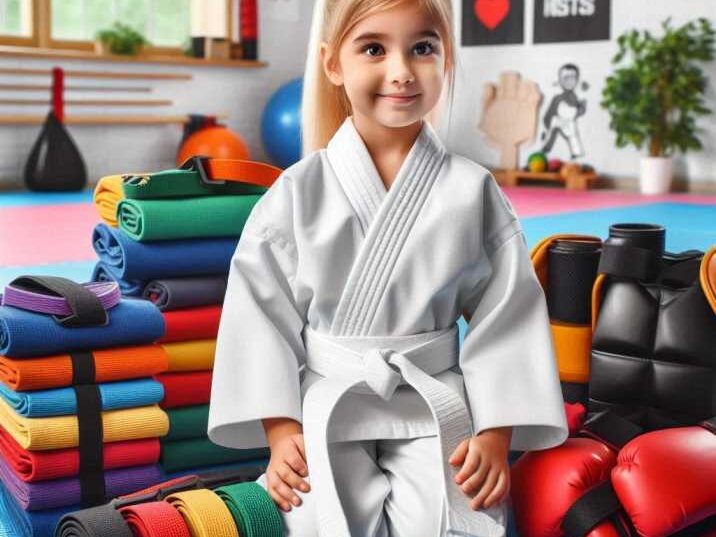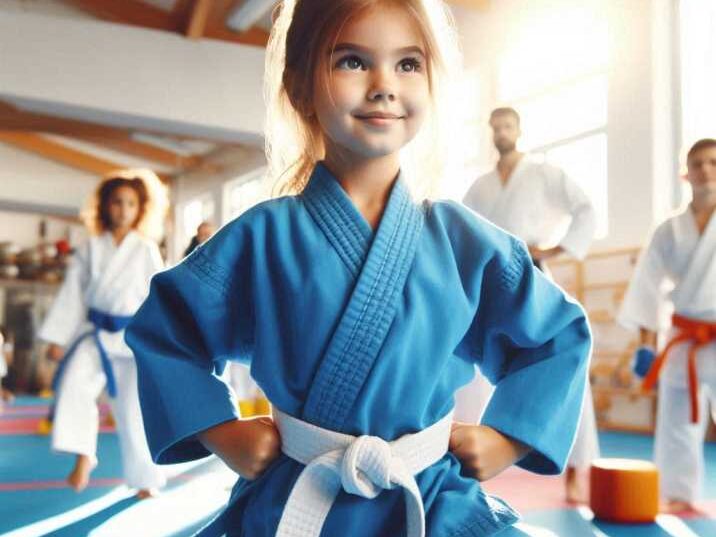Introduction
Table of Contents
Starting martial arts can be exciting for kids and reassuring for parents who want safe and healthy activities. One of the first questions families ask is, “What gear do we really need?”
Having the right gear makes training safe, comfortable, and fun. It also helps kids build confidence as they step onto the mat for the first time. Parents want to know what is essential, what is optional, and how much it will cost.
This guide breaks everything down in simple language. You will learn what belongs in a martial arts gear list for beginners, why each item matters, and how to choose wisely. By the end, you will have a clear checklist to help your child train safely and effectively.

What a Martial Arts Gear List Means
When people talk about a martial arts gear list for beginners, they mean the basic equipment needed for training. This usually includes clothing, protective gear, and practice tools.
Each martial art may require different items. For example:
- Karate and Taekwondo focus on uniforms and belts.
- Judo and Jiu-Jitsu add mats and grips.
- Kickboxing and Muay Thai require gloves and pads.
A beginner’s gear list should focus on safety, comfort, and practicality. You do not need to buy everything at once. Start with the essentials, then add more as your child progresses.
Benefits of Having the Right Gear for Kids
1. Safety and Protection
The number one reason for proper martial arts gear is safety. Beginner kids are still learning balance, control, and technique, which makes them more likely to stumble or strike incorrectly. Gloves cushion their hands and wrists, while shin guards protect delicate bones in the legs. Mouthguards prevent painful dental injuries during sparring. When kids are properly protected, parents can feel more confident letting them participate in training and practice.
2. Confidence Boost
Kids often feel shy or uncertain when trying something new. Wearing a proper uniform and protective gear helps them fit in with the class and feel like part of the group. This sense of belonging boosts confidence and keeps them motivated. When a child feels like a “real martial artist,” they take training more seriously and stay committed for the long term. Confidence gained in martial arts often carries over to school, sports, and daily life.
3. Better Performance
The right gear supports natural movement and reduces restrictions. A lightweight uniform lets kids kick higher and punch with better speed. Well-fitted gloves give grip and stability without weighing the hands down. Good shin guards absorb impact so kids can practice kicking drills without hesitation. By improving comfort and function, gear allows children to focus on learning skills instead of being distracted by discomfort or fear of injury.
4. Hygiene and Comfort
Martial arts involve close physical contact, which makes hygiene critical. Clean uniforms reduce the spread of germs and sweat buildup. Personal protective items like gloves and mouthguards should never be shared to avoid health risks. Comfortable gear also prevents skin irritation, rashes, and overheating during long sessions. When kids feel clean and comfortable, they perform better and enjoy training more. Parents also benefit from fewer health concerns and less worry about hygiene.
5. Discipline and Respect
Martial arts teach values beyond physical skills, and caring for gear is part of that training. Kids learn to fold uniforms neatly, clean protective gear, and keep everything organized. This responsibility builds discipline and teaches respect for the tools that keep them safe. Over time, children understand that respecting their gear is part of respecting their training, their instructors, and themselves. These habits of care and responsibility often extend beyond the dojo into daily life.
Possible Risks or Concerns
1. Cost
Martial arts gear can be expensive if parents go straight for top brands. A full set with uniform, gloves, and pads may cost over $200. The good news is many schools offer starter sets at lower prices. Parents can save money by buying only the essentials in the beginning and adding more gear later as the child progresses.
2. Fit and Comfort
Ill-fitting gear can cause more problems than it solves. A uniform that is too tight may limit movement, while oversized gloves or shin guards can slip and cause accidents. Poor fit also leads to skin irritation, blisters, or distraction during training. Parents should always check size charts and ask instructors for guidance before buying.
3. Injury from Poor-Quality Gear
Cheap gear often lacks proper padding or strong stitching, which increases the risk of injuries. Gloves may tear easily, or shin guards may not absorb enough impact. Kids need equipment that can handle regular use without breaking down. Choosing durable, safety-tested gear ensures better protection and peace of mind for parents.
4. Overbuying
It is common for families to feel pressure to buy every piece of martial arts gear at once. This often leads to wasted money on items that may not be needed until later stages of training. Beginners should focus only on the basics like uniforms and mouthguards. Extra gear can be added once the child shows steady progress and starts sparring or advanced drills.
The solution is to focus on essentials first and always choose safety over looks.
Safety Tips and Best Practices
1. Buy the Right Size
Gear that is too big can slip during practice, while gear that is too small can cause discomfort and restrict movement. Always check the manufacturer’s size chart and get your child to try on items before training. A proper fit keeps kids safe and confident on the mat.
2. Check Quality
High-quality gear has strong stitching, firm padding, and is made by trusted brands. Poorly made items may tear or fail during training, which increases the risk of injury. Parents should invest in reliable gear that lasts and provides solid protection.
3. Clean Regularly
Martial arts involve close contact and sweat, so hygiene is essential. Wash uniforms after each class, sanitize gloves, and let pads air dry. Regular cleaning prevents odors, germs, and skin issues, keeping training safe and healthy for kids.
4. Replace When Worn
Even the best gear wears out with time. Cracked shin guards, loose gloves, or torn uniforms no longer provide proper protection. Parents should check gear often and replace it when it shows signs of wear to keep their child safe during practice.
5. Listen to Instructors
Every martial art has different gear needs, and instructors know what works best for beginners. Parents should follow their guidance when buying equipment. This ensures kids have only what they truly need for safe and effective training.
Martial Arts Gear List for Beginners
1. Uniforms (Gi or Dobok)
A martial arts uniform, called a Gi in Karate or Jiu-Jitsu and a Dobok in Taekwondo, is the most recognizable part of training. It is usually made from lightweight cotton or a cotton-blend, which allows kids to move freely without overheating. Reinforced stitching keeps the uniform durable during grappling, kicking, and frequent washes. A proper belt is included to show rank and discipline, making kids feel proud of their progress.
2. Belts
Belts are more than just a piece of cloth; they represent progress, discipline, and achievement. Each color indicates a new level of skill, starting from white for beginners and progressing through various stages. Learning how to tie the belt correctly is also part of training and teaches respect for tradition. For kids, earning a new belt is a major confidence boost and a visible reminder of their hard work.
3. Protective Gear
Headgear
Headgear is used during sparring to protect against accidental bumps or strikes. It is padded around the forehead, ears, and sides to reduce the chance of cuts or bruises. Beginners may not need it right away, but it becomes important once sparring starts. Choosing lightweight headgear that fits well ensures kids stay safe without feeling uncomfortable.
Mouthguard
A mouthguard is essential for all striking and sparring activities. It protects teeth, gums, and the jaw from impact. There are two common types: boil-and-bite guards that mold to the child’s teeth at home, and custom-fit guards made by dentists. Parents should make sure their child always wears a mouthguard during contact drills to avoid painful injuries.
Gloves
Gloves are necessary for striking martial arts like boxing, Muay Thai, or kickboxing. They protect the knuckles, wrists, and opponent during punches. Kids’ gloves usually come in lighter weights, such as 6oz, 8oz, or 10oz, depending on age. Proper padding is important to reduce injury, and gloves should fit snugly but not too tightly.
Shin Guards
Shin guards protect the lower legs during kicking practice. Without them, repeated kicks can cause painful bruises or injuries. Foam shin guards are lightweight and good for beginners, while leather-covered guards offer more durability. A secure fit with straps or elastic keeps them from sliding during drills.
Groin Protector
For boys, a groin protector is a must-have in sparring sessions. It shields against accidental low strikes, which can be very painful. The protector should fit securely without restricting movement. It may not be needed in non-contact training, but once sparring begins, it becomes an important piece of safety equipment.
4. Training Accessories
Hand Wraps
Hand wraps are long strips of fabric used under gloves to provide extra wrist and knuckle support. They keep joints stable during punching drills and prevent injuries. Kids’ wraps are usually shorter than adult versions, making them easier to manage. They should always be worn with gloves to maximize protection.
Kick Pads/Focus Mitts
Kick pads and focus mitts are training tools used by instructors or partners to practice strikes. They allow kids to work on accuracy, speed, and power safely. While not required for every beginner, having them at home can help kids practice outside class. Quality pads with firm padding last longer and provide better shock absorption.
Water Bottle
Hydration is crucial during martial arts classes, especially for children who sweat a lot during drills. A reusable water bottle encourages kids to drink regularly and stay refreshed. Parents should pack it for every session to keep energy levels up and prevent dehydration.
Gym Bag
A gym bag helps keep all martial arts gear organized in one place. Kids can carry uniforms, gloves, belts, and water bottles without losing items. Bags also protect clean gear from mixing with dirty shoes or school supplies. Having a dedicated martial arts bag teaches kids responsibility for their own equipment.
5. Footwear (Optional)
Most martial arts are practiced barefoot, especially on mats, to build balance and grip. However, some schools allow martial arts shoes, which are lightweight and flexible. These can be useful for outdoor training, cold floors, or hygienic reasons. If used, shoes should be specifically designed for martial arts and not regular sneakers, since they need to allow free movement.

Comparison Table: Essential vs. Optional Gear
| Gear Item | Essential for Beginners | Optional |
|---|---|---|
| Uniform (Gi/Dobok) | Yes | No |
| Belt | Yes | No |
| Mouthguard | Yes | No |
| Gloves | Yes (if striking) | No |
| Shin Guards | Yes (if sparring) | No |
| Headgear | No | Yes |
| Hand Wraps | No | Yes |
| Kick Pads/Mitts | No | Yes |
| Martial Arts Shoes | No | Yes |
| Gym Bag | No | Yes |
Conclusion
The right martial arts gear list for beginners helps kids train safely, comfortably, and with confidence. Parents can start small, focusing on essentials like uniforms, belts, and mouthguards. Over time, you can add protective gear and training tools as your child progresses.
Investing in the right equipment sets a strong foundation for discipline, respect, and skill. With the right gear, kids can focus on learning and enjoying martial arts without worry.
FAQs
1. Do kids need all the gear right away?
No, start with essentials like uniforms and mouthguards. Add more gear as your child advances.
2. How much does beginner martial arts gear cost?
Basic sets range from $50 to $150, depending on quality and style.
3. Can siblings share martial arts gear?
Uniforms can be shared, but personal items like mouthguards and gloves should not be shared for hygiene reasons.
4. How often should gear be replaced?
Uniforms may last a year or more. Protective gear should be replaced if it shows wear or no longer fits.
5. Do all martial arts require the same gear?
No. Striking arts need gloves and shin guards, while grappling arts focus more on uniforms and mats.


